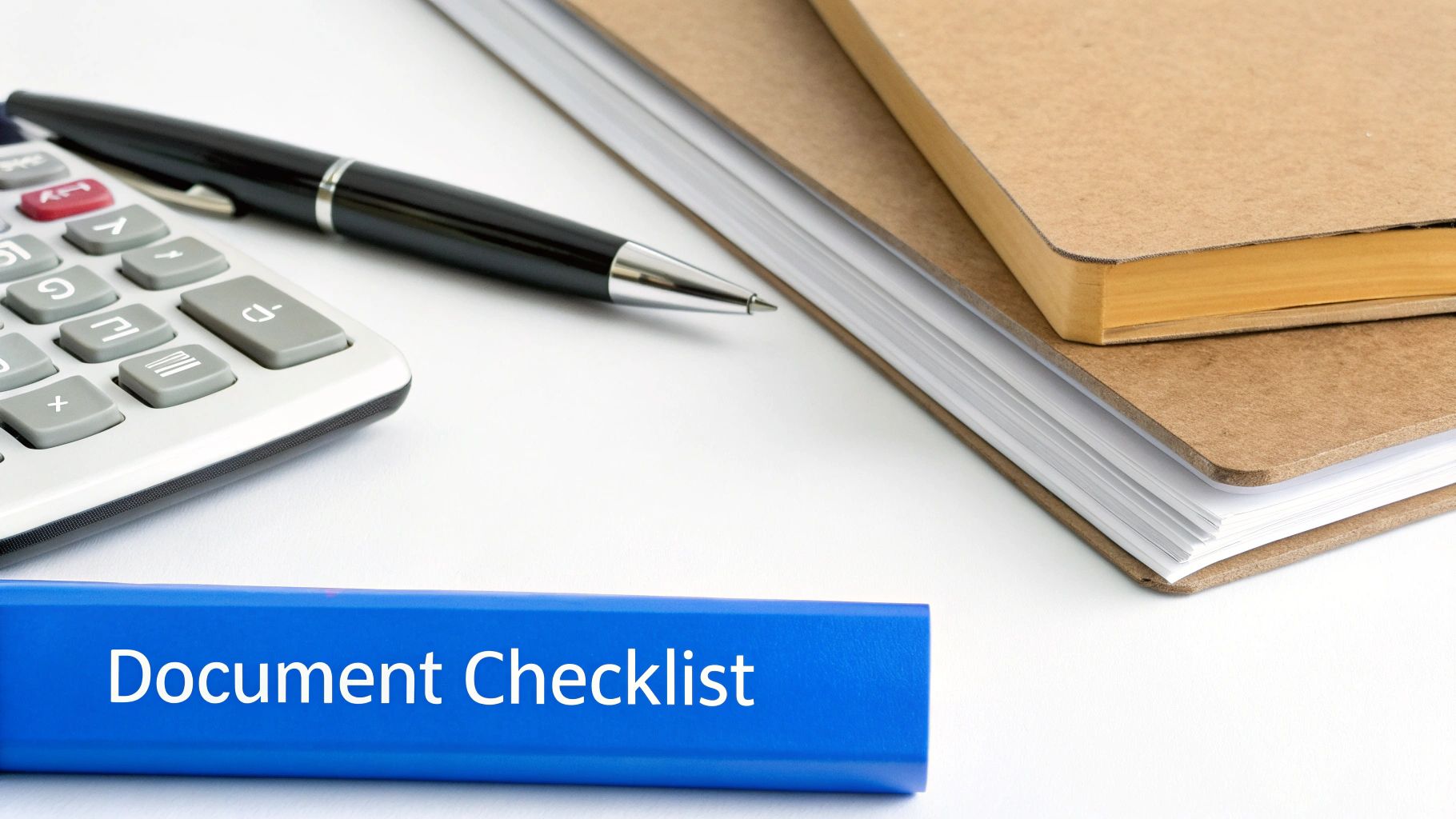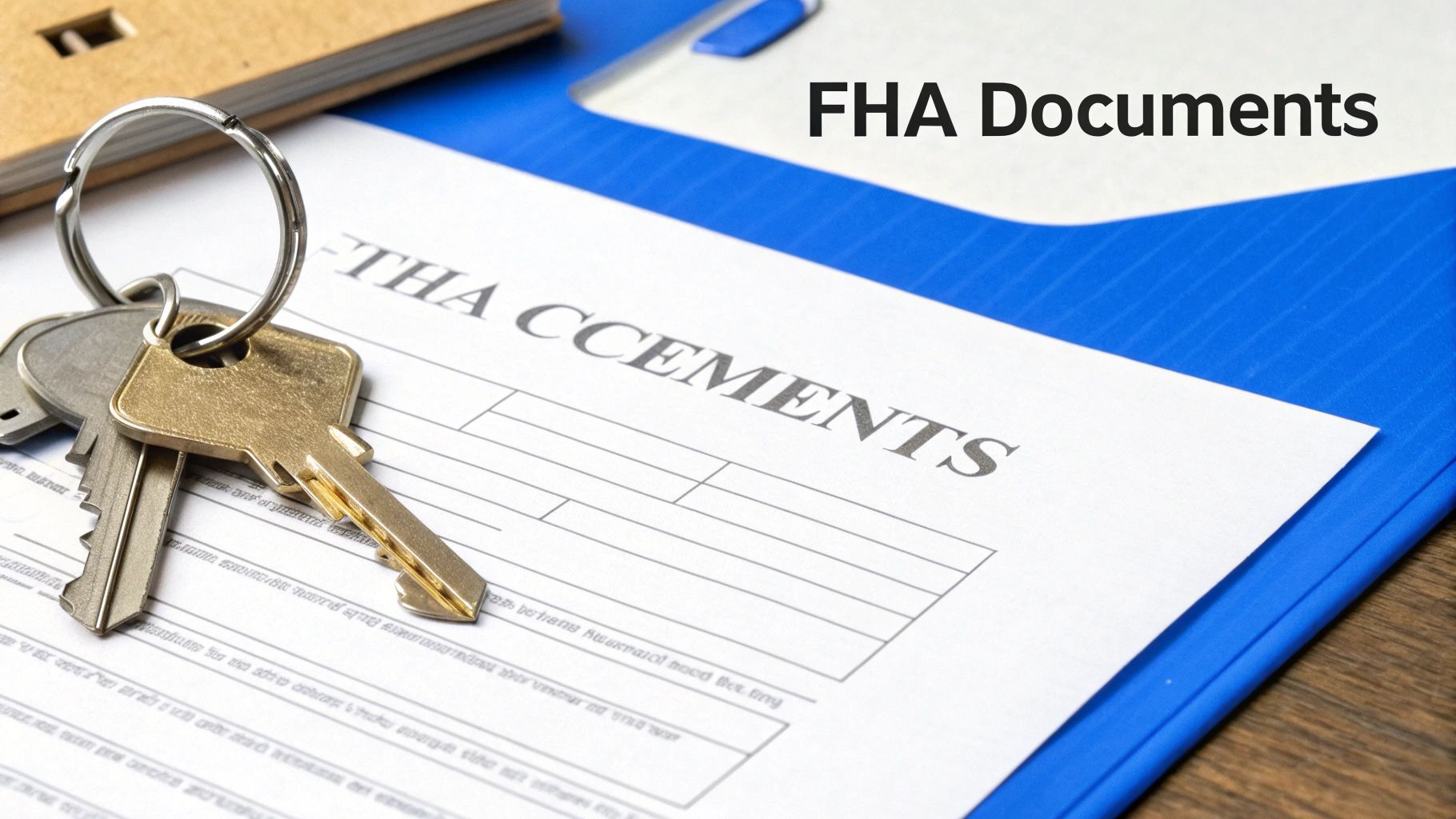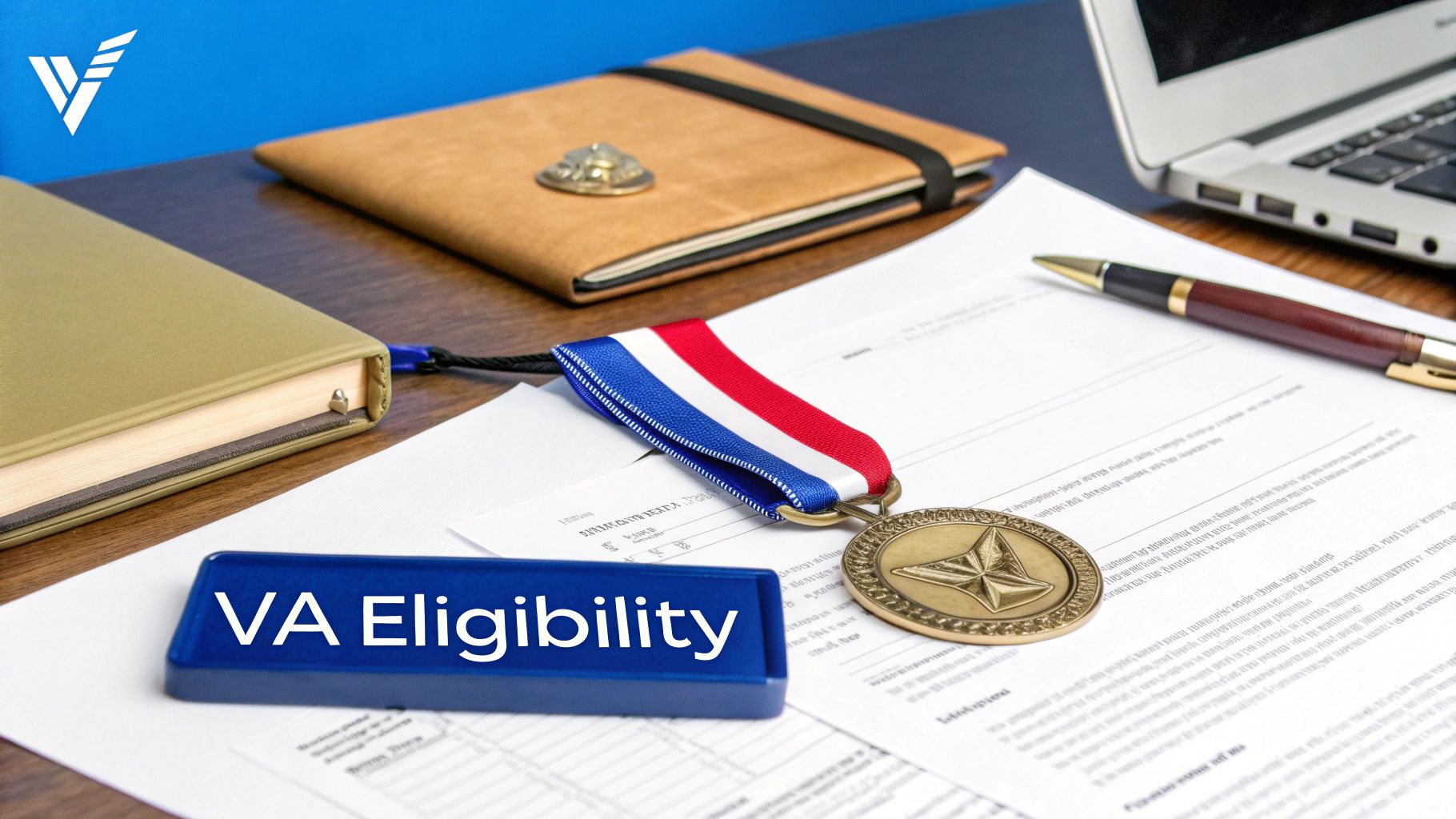Getting Started with Your Mortgage Documents
This mortgage document checklist provides six essential lists that mortgage brokers need to efficiently onboard new clients. Using these checklists will streamline your workflow and improve the borrower experience from the initial application to the final closing. Successfully navigating the mortgage process requires organized document collection. This checklist covers everything from standard mortgage applications and FHA loans to VA loans and the unique needs of self-employed borrowers. We’ll also cover closing document requirements and how tools like Superdocu can enhance your document management. This article covers: Standard Mortgage Application, Freddie Mac Loan Documentation Matrix, FHA Mortgage, VA Loan, Self-Employed Borrower, and Closing Documentation Checklists.
Table of Contents
1. Standard Mortgage Application Document Checklist
A Standard Mortgage Application Document Checklist is a crucial tool for both borrowers and mortgage brokers. It outlines all the essential documents required by lenders during the mortgage application process. This checklist acts as a roadmap, ensuring a smoother, more efficient experience for everyone involved. For mortgage brokers, it’s an indispensable tool for successful client onboarding, minimizing delays and frustration. Having a readily available checklist helps set clear expectations from the outset and allows brokers to guide their clients effectively. This organized approach streamlines the entire process, from initial consultation to final loan approval.

This checklist typically includes categorized sections for personal identification, income verification, asset documentation, and property information. Commonly requested documents include:
- Personal Identification: Government-issued photo ID (e.g., driver’s license, passport), Social Security card.
- Income Verification: Pay stubs (generally covering the most recent 30 days), W-2 forms (for the past two years), tax returns (for the past two years), proof of any additional income (e.g., self-employment, investments).
- Asset Documentation: Bank statements (covering the most recent two months), investment account statements, retirement account statements, documentation of any other assets (e.g., vehicles, property).
- Property Information: Purchase agreement, appraisal report.
Using a standardized mortgage document checklist offers numerous advantages. It provides a clear roadmap for borrowers to gather the necessary documentation, reducing back-and-forth communication between lenders and applicants. It also helps borrowers understand the mortgage application process and can be used across multiple lenders with minimal modifications. For mortgage brokers, this means less time spent chasing paperwork and more time focusing on client needs. Gathering the necessary mortgage documents can be a complex process. It’s essential to ensure you comply with all legal requirements when verifying information provided by borrowers. For a comprehensive understanding of these guidelines, refer to this helpful resource: legal guidelines for conducting employee background checks
Actionable Tips for Mortgage Brokers:
- Provide the Checklist Upfront: Give your clients the checklist at the beginning of the process to set clear expectations.
- Explain Each Document’s Purpose: Clearly explain why each document is needed and how it contributes to the loan application process.
- Offer Assistance with Document Gathering: Provide support and guidance to clients who may struggle to obtain certain documents.
- Maintain Organized Records: Implement a secure system for storing and managing client documents.
- Stay Updated on Lender Requirements: Be aware of any specific document requirements from different lenders.
- Digital Solutions: Consider using digital document collection and management tools to streamline the process.
While the standard mortgage document checklist is incredibly useful, it’s important to be aware of its potential drawbacks. It may not account for unique borrower situations or special loan programs. It can also be overwhelming for first-time homebuyers, and it doesn’t always explain alternatives for difficult-to-obtain documents. Additionally, digital submission guidelines are often not included. For mortgage brokers, adapting the checklist to individual client circumstances and staying informed about lender-specific requirements are crucial for success.
Examples of successful implementations of mortgage document checklists include Fannie Mae’s Uniform Residential Loan Application checklist and lender-specific guides like Chase Mortgage’s ‘ReadyMind’ document preparation guide. These checklists are valuable resources for both borrowers and mortgage professionals. They are popularized by institutions like the Consumer Financial Protection Bureau (CFPB), Fannie Mae and Freddie Mac, and major mortgage lenders.
2. Freddie Mac Loan Documentation Matrix
For mortgage brokers aiming to efficiently onboard new clients and ensure a smooth loan process, particularly for loans intended for sale to Freddie Mac, the Freddie Mac Loan Documentation Matrix is an indispensable tool. This matrix serves as a comprehensive mortgage document checklist, outlining precisely which documents are needed for income verification, asset assessment, employment history, and other qualifying factors. It’s structured to provide clear requirements based on the specific loan type, individual borrower profile, and findings from Freddie Mac’s automated underwriting system, Loan Product Advisor (LPA).

This matrix format simplifies the often-complex process of assembling a complete loan file. It offers distinct guidelines for various income types, such as salary, self-employment, retirement, and investment income, recognizing that different income sources require different documentation. Furthermore, the matrix offers alternative documentation pathways. For instance, if a borrower cannot provide traditional pay stubs, the matrix might suggest alternative documentation like bank statements reflecting direct deposit. This flexibility is crucial for handling diverse borrower scenarios and ensuring a smooth process. The matrix also aligns with Loan Product Advisor (LPA) findings, helping brokers proactively address potential issues early in the process.
This deserves a prominent place on any mortgage broker’s mortgage document checklist because it provides definitive guidance, particularly when dealing with loans intended for the secondary market. By adhering to these guidelines, brokers can significantly reduce the risk of documentation errors that could delay or even prevent the sale of a loan to Freddie Mac. The matrix has specialized sections for self-employed borrowers and complex income situations, which are often challenging scenarios in mortgage lending. It’s widely recognized as an authoritative standard within the mortgage industry.
Pros:
- Provides definitive guidance for loans sold to Freddie Mac.
- Reduces the risk of documentation errors.
- Contains specific instructions for self-employed borrowers and complex income scenarios.
- Industry-wide recognition as an authoritative standard.
Cons:
- Can be technically complex for consumers.
- Requirements are subject to change based on market conditions.
- Can be more stringent than requirements for portfolio lenders.
- Focuses solely on conforming loans, excluding jumbo or non-QM products.
Examples of Implementation:
- Using the official Freddie Mac Single-Family Seller/Servicer Guide Document Matrix.
- Creating lender overlay matrices that build upon the Freddie Mac requirements.
- Developing customized checklists based on Freddie Mac standards for regional bank use.
Tips for Mortgage Brokers:
- Always verify you’re using the most current version of the matrix.
- Pay close attention to the specific documentation path indicated by the LPA findings.
- Be prepared to provide alternative documentation if primary sources aren’t available.
- Clearly explain any documentation exceptions.
By using the Freddie Mac Loan Documentation Matrix, mortgage brokers can create a robust mortgage document checklist for new client onboarding, covering everything from income verification to asset documentation. This proactive approach helps streamline the loan process and minimizes the risk of delays or rejections, ultimately contributing to a more efficient and successful lending experience. Learn more about Freddie Mac Loan Documentation Matrix
3. FHA Mortgage Document Checklist
Navigating the mortgage process can be complex, especially when dealing with government-backed loans like those offered through the Federal Housing Administration (FHA). An FHA mortgage document checklist is a crucial tool for both borrowers and mortgage brokers to ensure a smooth and efficient loan application process. This specialized checklist helps organize the numerous documents required for FHA loans, which are designed for individuals with lower credit scores or smaller down payments. It encompasses standard mortgage documentation along with specific FHA requirements essential for these government-insured loans. Using a comprehensive checklist keeps everyone organized and on track, minimizing potential delays and frustrations. This is particularly important for mortgage brokers who need to efficiently manage client onboarding and ensure compliance.

The FHA mortgage document checklist includes items like standard income verification (pay stubs, W-2s, tax returns), asset documentation (bank statements, investment accounts), credit reports, and employment history. However, it also incorporates FHA-specific forms, such as the HUD-92900-A (Addendum to Application), and documentation related to the minimum required investment (MRI). This checklist also addresses gift funds, providing templates for gift letters and outlining source of funds verification procedures. Additionally, it offers guidelines for property condition documentation, a critical aspect of FHA loans.
For mortgage brokers, using a dedicated FHA checklist streamlines client onboarding by ensuring all necessary documentation is collected upfront. This checklist should include:
- Borrower Information: Full legal name, Social Security number, date of birth, current address, contact information.
- Income Documentation: Pay stubs (last 30 days), W-2 forms (last two years), tax returns (last two years), self-employment documentation (if applicable).
- Asset Documentation: Bank statements (last two months), investment account statements, retirement account statements.
- Credit Report: Obtain authorization from the borrower to pull their credit report.
- Employment History: Verification of employment for the past two years.
- FHA-Specific Documents: HUD-92900-A, documentation for minimum required investment (MRI), gift letters (if applicable), source of funds documentation.
- Property Information: Address, appraisal report, purchase agreement.
- Other: Social Security Number verification, any additional documentation required by the lender.
Examples of FHA Mortgage Document Checklists:
- HUD’s official FHA loan documentation checklist.
- Lender-specific FHA checklists from companies like Quicken Loans/Rocket Mortgage.
- Housing counseling agency preparation guides for FHA borrowers.
Pros:
- Specifically tailored for the unique requirements of FHA loans.
- Includes guidance for down payment assistance programs.
- Provides clarity on government-specific forms and disclosures.
- Accommodates borrowers with non-traditional credit histories.
Cons:
- More paperwork required than conventional loans.
- Stricter property condition documentation requirements.
- Less flexibility in documentation alternatives.
- Can be confusing for borrowers unfamiliar with government programs.
Tips for Using an FHA Mortgage Document Checklist:
- Start gathering documents early in the process.
- Pay close attention to property condition requirements.
- Keep meticulous records of all gift funds and down payment sources.
- Work closely with an FHA-experienced loan officer.
When to Use an FHA Mortgage Document Checklist: This checklist is essential whenever a borrower is applying for an FHA loan. For mortgage brokers, it’s a vital tool for efficient and compliant client onboarding. Its detailed nature helps ensure all necessary information is collected promptly, streamlining the loan origination process and reducing the likelihood of delays or complications.
4. VA Loan Documentation Checklist
A VA Loan Documentation Checklist is a crucial tool for mortgage brokers working with veterans, active-duty service members, and eligible surviving spouses. It ensures they gather all necessary paperwork for a smooth and efficient mortgage process. This specialized mortgage document checklist helps navigate the unique requirements of VA-backed loans, which are guaranteed by the U.S. Department of Veterans Affairs. Using a VA Loan Documentation Checklist helps mortgage brokers demonstrate their expertise and build trust with military clients by streamlining what can be a complex and sometimes overwhelming process.

This checklist differs from a standard mortgage document checklist by focusing on military service-related documentation and VA-specific forms. It outlines everything from proof of service and eligibility to specific forms required by the VA for loan processing. Key features often included are guidance on obtaining the Certificate of Eligibility (COE), which confirms the borrower’s VA loan benefit entitlement; DD-214 requirements (discharge papers for veterans); Statement of Service formats for active-duty personnel; and necessary VA forms such as the 26-1880 (Request for a Certificate of Eligibility) and 26-1802a (Request for Certificate of Reasonable Value). The checklist also addresses documentation for VA funding fee calculations and potential exemptions based on disability or other factors.
For mortgage brokers, a comprehensive VA Loan Documentation Checklist might include:
- Personal Information: Full legal name, date of birth, social security number, current address, contact information.
- Income Verification: Pay stubs (generally two months), W-2s (two years), tax returns (two years), other income documentation (e.g., retirement, disability).
- Asset Verification: Bank statements (two months), investment account statements, proof of other assets.
- Military Service Documentation: Certificate of Eligibility (COE), DD-214 (discharge papers), Statement of Service (for active duty), any relevant documentation related to disability rating for funding fee exemptions.
- VA-Specific Forms: Completed VA forms such as 26-1880 and 26-1802a.
- Credit History Authorization: Signed authorization for the broker to pull the client’s credit report.
- Purchase Agreement (if applicable): Copy of the signed purchase agreement for the property the veteran intends to purchase.
Pros:
- Streamlines the document collection process specific to VA loans.
- Ensures compliance with VA requirements.
- Builds client confidence by demonstrating expertise in VA lending.
- Often involves less stringent asset documentation than conventional loans.
Cons:
- Military documentation can be time-consuming to obtain.
- VA appraisal and property requirements are stricter than conventional loans.
- The checklist can be overwhelming for first-time VA loan users, requiring careful explanation from the broker.
Tips for Mortgage Brokers using a VA Loan Documentation Checklist:
- Advise clients to request their Certificate of Eligibility early in the process. This can often be done online through the VA’s eBenefits portal.
- Educate clients on the importance of organized and accessible military service records.
- Clearly explain VA funding fee implications based on their individual service and loan history.
- Prepare clients for the VA appraisal process and property requirements, which are often more stringent than those for conventional loans.
Examples of VA Loan Documentation Checklists: While not directly linkable, resources like Veterans United Home Loans, USAA, and Navy Federal Credit Union often provide guides and checklists related to VA loan documentation. Searching their websites for “VA loan checklist” or “military mortgage checklist” can be helpful.
By utilizing a VA Loan Documentation Checklist and following these tips, mortgage brokers can efficiently serve their military clients and ensure a successful VA loan process. This dedicated approach simplifies the complexities of VA loans, benefiting both the broker and the veteran seeking to utilize their hard-earned benefits.
5. Self-Employed Borrower Documentation Checklist
Securing a mortgage when you’re self-employed can feel like navigating a maze. Lenders scrutinize income stability and business viability more rigorously for entrepreneurs, freelancers, independent contractors, and small business owners than for traditional W-2 employees. That’s why a dedicated Self-Employed Borrower Documentation Checklist is essential for both borrowers and the mortgage brokers assisting them. This checklist ensures you’re equipped to demonstrate your financial health, streamlining the often-complex mortgage application process. This is a critical part of any comprehensive mortgage document checklist and is invaluable for mortgage brokers onboarding new self-employed clients.
For mortgage brokers, having a standardized self-employed client onboarding process is crucial. This checklist helps ensure you collect all necessary documentation upfront, minimizing delays and potential issues later in the process. This methodical approach builds trust with clients and portrays professionalism, setting you apart in a competitive market.
Here’s a breakdown of what this checklist should encompass:
- Business Tax Return Requirements (2-3 years): Providing tax returns for the past two to three years is standard practice. These returns offer a comprehensive view of your business’s financial performance and are a cornerstone of the lender’s income verification process.
- Personal Tax Return Analysis Guidelines (with all schedules): Lenders also review personal tax returns to assess your overall financial picture, including income from all sources, deductions, and liabilities. All schedules, such as Schedule C (Profit or Loss from Business) and Schedule SE (Self-Employment Tax), are crucial for accurate income calculation.
- Profit & Loss (P&L) Statement Templates and Requirements: A current year-to-date P&L statement is frequently required. This provides a snapshot of your business’s recent performance. Using a standardized template can ensure consistency and make the information easier for the lender to review. Mortgage brokers should be prepared to guide clients on creating accurate and comprehensive P&L statements.
- Business Bank Statement Analysis Frameworks: Lenders often analyze business bank statements to verify income deposits and identify any red flags. Consistent deposits and healthy cash flow contribute positively to the loan application.
- Business License and Entity Verification Documentation: Proof of legitimate business operation is necessary. This might include your business license, articles of incorporation, or other relevant registration documents, depending on your business structure (sole proprietorship, LLC, S-Corp, partnership, etc.).
Pros:
- Addresses the unique challenges of documenting self-employment income.
- Provides tailored approaches for various business structures.
- Includes guidance on handling business deductions and write-offs.
- May offer access to limited documentation programs, simplifying the process.
Cons:
- Requires significantly more documentation than for W-2 employees.
- Might reveal tax strategies that could reduce qualifying income.
- Often necessitates professional preparation of P&L statements.
- Documentation requirements can vary significantly among lenders.
Examples of Resources: Quicken Loans/Rocket Mortgage self-employed documentation guide, Better.com’s Self-Employed Mortgage Checklist, Guild Mortgage’s Business Owner Documentation Requirements.
Tips for Mortgage Brokers and Borrowers:
- Start Early: Begin gathering documentation at least 3-6 months before applying for a mortgage.
- Strategic Write-offs: Consider delaying major business write-offs if you plan to purchase a property soon.
- Professional Assistance: Work with an accountant familiar with mortgage qualification requirements for self-employed individuals.
- Transparency: Be prepared to explain any significant income fluctuations.
- Separate Finances: Maintain strictly separate personal and business expenses.
Learn more about Self-Employed Borrower Documentation Checklist
Organizations like the National Association of Self-Employed (NASE) and specialized mortgage brokers focusing on self-employed borrowers offer valuable resources. Fintech lenders are also developing alternative documentation approaches to simplify the process. By using a detailed Self-Employed Borrower Documentation Checklist, mortgage brokers can effectively onboard self-employed clients and guide them toward a successful mortgage application. This ensures a smoother, more efficient experience for all parties involved and solidifies the broker’s role as a trusted advisor.
6. Closing Documentation Checklist
A crucial step for both mortgage brokers and borrowers is the Closing Documentation Checklist. This comprehensive list outlines all the documents required at the final stage of the mortgage process, when the loan is formally executed and property ownership is transferred. Having a robust checklist helps ensure a smooth closing (settlement) meeting and prevents delays caused by missing paperwork. This is vital for mortgage brokers aiming to provide a seamless and professional experience for their clients. Learn more about Closing Documentation Checklist
For mortgage brokers specifically, this checklist serves as a critical tool for client onboarding and ensures they have everything needed to finalize the loan. This not only streamlines the process but also builds trust and confidence with the borrower. A well-organized closing process translates to happy clients and positive referrals.
For Mortgage Brokers: Client Onboarding Document Checklist:
Borrower Information:
- Full legal names, dates of birth, social security numbers, and contact information for all borrowers.
- Current residential addresses (past two years).
- Marital status and any applicable legal documentation (e.g., divorce decree, pre-nuptial agreement).
Financial Documentation:
- W-2s, pay stubs (most recent 30 days), and tax returns (past two years) for all borrowers.
- Bank statements (past two months for all accounts).
- Documentation of other income sources (e.g., investment income, alimony, child support).
- Asset statements (e.g., retirement accounts, investment portfolios).
- List of current debts (e.g., credit cards, auto loans, student loans).
Property Information:
- Purchase agreement.
- Appraisal report.
- Homeowners insurance policy information.
Loan Documentation:
- Loan Estimate.
- Closing Disclosure (received at least three business days before closing).
- Promissory Note.
- Mortgage/Deed of Trust.
Key Features and Benefits:
- Closing Disclosure Review Timeline: The checklist emphasizes the importance of reviewing the Closing Disclosure within the required three-day window before closing, allowing borrowers to identify any discrepancies and address them proactively. This is a key consumer protection mandated by the CFPB.
- Final Loan Documentation Inventory: Provides a detailed inventory of all documents needed at closing, preventing last-minute scrambles and potential delays. This organization is particularly beneficial for mortgage brokers managing multiple client files.
- ID and Payment Requirements: Clearly states the acceptable forms of identification and payment methods (cashier’s check, wire transfer) required at closing.
- Property Deed and Title Documentation: Outlines the necessary documentation related to property ownership transfer, ensuring a clear chain of title.
- Insurance Verification: Confirms homeowners insurance requirements are met, protecting both the borrower and the lender.
Pros:
- Sets clear expectations for the closing process.
- Helps prevent closing delays.
- Enables proactive preparation.
- Explains important consumer rights.
Cons:
- Often delivered late in the process.
- Can be overwhelming due to document volume.
- May not fully explain complex legal jargon.
- Doesn’t always clarify negotiable vs. required documents.
Actionable Tips:
- Review the Closing Disclosure immediately upon receipt and compare it to your Loan Estimate.
- Prepare questions for your loan officer before closing day.
- Bring proper identification and proof of insurance.
- Understand which costs require certified funds versus personal checks.
Why This Item Deserves Its Place:
The Closing Documentation Checklist is an indispensable tool for successful mortgage transactions. It empowers both borrowers and mortgage brokers with the knowledge and organization needed to navigate the complexities of closing, ultimately leading to a smoother, more efficient, and less stressful experience. Its importance in preventing delays, protecting consumer rights, and ensuring a legally sound closing makes it a cornerstone of the mortgage process.
Mortgage Document Checklist Comparison
| Document Checklist | Implementation Complexity 🔄 | Resource Requirements ⚡ | Expected Outcomes 📊 | Ideal Use Cases 💡 | Key Advantages ⭐ |
|---|---|---|---|---|---|
| Standard Mortgage Application Checklist | Medium – straightforward but broad | Moderate – typical borrower documents | Clear roadmap; reduces lender-applicant back-and-forth | Conventional mortgage applicants | Universally applicable; reduces confusion |
| Freddie Mac Loan Documentation Matrix | High – technical and detailed | High – specialized borrower data | Minimized documentation errors for secondary market loans | Conforming loans for secondary market sale | Authoritative standard; includes alternatives |
| FHA Mortgage Document Checklist | Medium – FHA-specific requirements | Moderate – government forms + extra | Ensures FHA compliance; supports lower-credit borrowers | FHA government-backed loans | Tailored for FHA; includes down payment & gift rules |
| VA Loan Documentation Checklist | Medium-High – military specific | Moderate – military & service docs | Facilitates VA eligibility and funding fee exemptions | VA loans for veterans and service members | Addresses military details; fewer asset docs needed |
| Self-Employed Borrower Checklist | High – complex income proof | High – extensive financial/business docs | Supports income verification for self-employed borrowers | Self-employed and small business owners | Handles diverse business structures; detailed guidance |
| Closing Documentation Checklist | Medium – focused on final stage | Moderate – final legal and insurance docs | Prevents closing delays; clarifies closing process requirements | Mortgage closing phase | Clear closing expectations; consumer rights explained |
Streamlining Your Mortgage Document Workflow with Superdocu
Successfully navigating the mortgage process requires meticulous attention to detail, especially when it comes to documentation. This mortgage document checklist, covering everything from standard applications to specialized needs like VA loans and self-employed borrowers, provides a comprehensive overview of the necessary paperwork. We’ve explored the key requirements for each loan type, including insights from resources like the Freddie Mac Loan Documentation Matrix, ensuring you have a solid grasp of what’s needed for each scenario. Mastering these checklists, from initial application through closing, is crucial for mortgage brokers to ensure a smooth and efficient process for their clients. This streamlined approach minimizes delays, reduces errors, and ultimately contributes to a more positive client experience, leading to greater client satisfaction and business growth.
Remember, efficient document management is paramount to success in the mortgage industry. Whether you’re dealing with FHA loans, VA loans, or the complexities of self-employed borrowers, a well-organized system is essential. Having a clear understanding of the required documents, as outlined in this mortgage document checklist, empowers you to confidently guide your clients through each step of the process.
Ready to simplify your mortgage document workflow and elevate your client onboarding process? Superdocu provides a centralized platform to collect, manage, and securely store all your client’s mortgage documents, automating the tedious aspects of your checklist. Visit Superdocu today and discover how it can transform your business.
